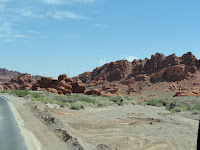On August 30th, our travels take us back through Las Vegas and north 200 miles to St. George, Utah where we will visit Zion National Park. On the way, we were given the option to tour Valley of Fire State Park and the Lost City Museum.
Taken directly for the Parks website --
The Valley of Fire derives its name from red sandstone formations, formed from
great shifting sand dunes during the age of dinosaurs, 150 million years ago.
Complex uplifting and faulting of the region, followed by extensive erosion,
have created the present landscape.
Other
important rock formations include limestones, shales, and conglomerates.
Prehistoric users of the Valley of Fire included the Basket Maker people and
later the Anasazi Pueblo farmers from the nearby fertile Moapa Valley.
The span of
approximate occupation has been dated from 300 B.C.E. to 1150 C.E. Their visits
probably involved hunting, food gathering, and religious ceremonies, although
scarcity of water would have limited the length of their stay. Fine examples of
rock art left by these ancient peoples can be found at several sites within the
park.
 |
| Valley of Fire |
 |
| Valley of Fire |
Once out of
the park, we followed directions to the museum.
When we arrived, we realized there was no parking for a motor home the
size of ours. We parked on the shoulder
of the road across the street. Before
touring the museum, we had a bite of lunch.
Terry also needed a break from driving through the park (lots of curves
and hills). Following is the history of
the museum taken from the Lost City
Museum website.
Established:
1935 The Lost City Museum was built by
the National Park Service to exhibit artifacts that were being excavated from
Pueblo Grande de Nevada. These Anasazi
Indian sites were being threatened by the waters of Lake Mead as it backed up
behind the newly built Hoover Dam. Eventually,
when the lake was filled to capacity, about five miles of sites had been
inundated or undercut by the water.
The
Civilian Conservation Corps assisted in the excavation of the sites and the
construction of the museum building. The building was constructed of sun-dried
adobe brick in a pueblo- revival style. The
museum also served as the park headquarters for the Boulder Dam State Park that
was established at Lake Mead.
No comments:
Post a Comment